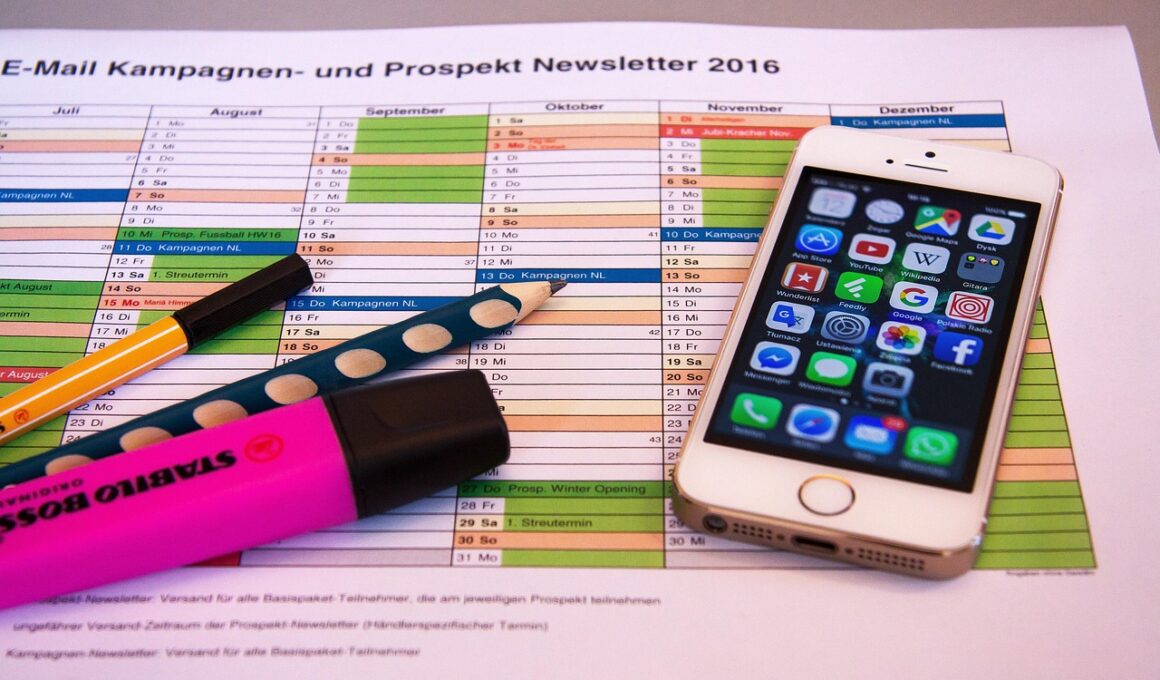How to Avoid Common Scheduling Mistakes in Newsletter Marketing
In the ever-evolving world of newsletter marketing, it’s crucial to understand the common scheduling mistakes that many marketers make. Failing to address these pitfalls can lead to lower engagement rates and missed opportunities. One of the largest mistakes is inconsistency in sending times. Subscribers appreciate receiving newsletters at expected intervals. Establish a routine to avoid disappointing your audience. Consider segmenting your list for more targeted delivery, enhancing relevance and responsiveness. Additionally, failing to monitor analytics can jeopardize your campaign. Regularly tracking open and click rates ensures optimization of your content strategy. Misjudging audience preferences in frequency leads to higher unsubscribe rates, a detrimental outcome for any newsletter campaign. Don’t bombard users with emails; find the sweet spot for engagement. Use A/B testing to discover what timing works best for your audience. Lastly, lack of content planning creates chaos in scheduling. A well-structured editorial calendar can be invaluable. Schedule seasonal themes or special promotions in advance to maximize impact and engagement. By avoiding these common pitfalls, you can streamline your newsletter marketing efforts and connect more effectively with subscribers, ensuring maximum results.
Among the most damaging scheduling mistakes is relying solely on automated systems for sending newsletters. While automation can enhance efficiency, over-dependence on it might lead to disengagement. Subscribers can feel neglected if newsletters lack personal touches. Customizing content encourages familiarity and connection. Moreover, it’s advisable not to overlook the importance of timing. Sending emails at peak times may significantly increase open rates. Analyze your target audience to determine their most active times. Another mistake is neglecting mobile optimization. Many users read emails on their mobile devices. Ensure your newsletters are responsive and visually appealing across various devices to maximize effectiveness. Additionally, inconsistent branding can confuse subscribers. Maintain a uniform voice and visual identity across all newsletters to build brand recognition. Poorly constructed subject lines are another common error. Craft compelling and clear subject lines to entice subscribers. Experiment with various styles and formats. Failing to include effective calls to action can hinder your newsletters’ performance. Guide your readers on what actions to take next. By addressing these pitfalls head-on, you set yourself on a path to create newsletters that resonate with your audience and drive better results.
Understanding Your Audience’s Needs
The heart of any successful newsletter is understanding the audience’s needs and preferences. Misjudging these can lead to disastrous results, including low engagement and high unsubscribe rates. Constantly engage with your audience through surveys or polls to gather insights regarding content preferences. Creating personas can also be beneficial, as it helps define which topics resonate best with different segments of your audience. Additionally, remember that relevant content is more important than frequency. A newsletter filled with valuable insights is likely to engage subscribers more than frequent but irrelevant emails. Seek to provide value in each communication. Regular feedback from your audience allows you to tailor your content, ensuring it’s pertinent. Utilizing advanced analytics tools enables deeper understanding of subscriber behavior. Monitor how often they open emails, which links they click, or the content they share. This data can vastly improve your scheduling strategy. Don’t shy away from adjustments based on analytical insights. Further, integrating user-generated content allows for interactive experiences that engage readers effectively. Sharing testimonials or featuring subscriber contributions adds authenticity and fosters community among your readers.
Another common mistake in newsletter scheduling is ignoring seasonal trends or market changes. A successful marketing strategy must adapt and evolve with the times. For instance, festive seasons bring a unique opportunity to engage your audience creatively. Plan newsletters around holidays, industry events, and current trends. Regularly assess industry news or shifts in consumer behavior to stay relevant. Failing to capitalize on relevant zeitgeist can render your newsletters irrelevant. Also, ensure your call-to-action links lead to the anticipated content. Misleading links can frustrate subscribers, resulting in a damaged rapport. Always test links before sending your newsletters to ensure seamless navigation. Lack of attention to detail in your format leads to inconsistency. Ensure all newsletters maintain a polished and professional appearance. This includes proofreading content for errors, maintaining a consistent layout, and ensuring all images are correctly displayed. Additionally, avoid lengthy emails. While thorough information is valuable, excessive wordiness may deter readers. Break up content into easily digestible sections while maintaining a clear and focused message. Timely adjustments to your scheduling based on consumer feedback and trends will ensure the continued relevancy of your newsletters.
Scheduling and Frequency
Finding the ideal frequency for sending newsletters can be a daunting task. One of the first steps is to conduct audience research to gauge their content consumption habits. Too frequent newsletters might irritate subscribers, while infrequent communications may lead them to forget about your brand. Striking the right balance enhances engagement. Additionally, keep your audience informed about how often they should expect newsletters. Transparency in scheduling builds trust and confidence in your brand. Increase opportunities for engagement by segmenting your audience and tailoring messages. For example, new subscribers may appreciate more frequent content initially to foster connection. You can then scale back based on engagement levels. Conversely, long-term subscribers might find too frequent emails annoying. Testing different frequency strategies through A/B testing can provide valuable insights. You might find that some segments respond better to weekly updates, while others prefer monthly summaries. Be flexible in your approach and always prioritize engagement over volume. Once you establish a preferred frequency, maintain consistency over time. This instills confidence in your audience and sets clear expectations, allowing for improved engagement metrics.
One often-overlooked factor in newsletter scheduling is the localization of sending times. If your audience is global, the timing of your emails can impact open rates considerably. Tailoring the sending time according to recipients’ time zones can optimize engagement metrics. Consider using tools that facilitate automatic adjustment based on geographical data for better outcomes. This attention to detail shows your regard for the subscribers’ experience. Moreover, utilizing personalization helps cut through the content clutter. Personalized subject lines or greeting can significantly elevate open rates, making the reader feel special. But avoid overstepping bounds; personalization must feel genuine rather than forced. Regularly assess your metrics to understand which subject lines attract the most attention. Avoid using spammy formats or triggers that can cause emails to be redirected to junk folders. A/B testing is invaluable in understanding what resonates. Additionally, ensure your content aligns with subscribers’ expectations based on previous interactions. The ultimate goal is to nurture relationships rather than merely pushing content. Establishing a system to collect feedback post-newsletter can provide insights for future scheduling and content improvements.
Conclusion and Best Practices
In conclusion, avoiding common scheduling mistakes in newsletter marketing requires a blend of strategic planning and ongoing engagement with your audience. By understanding your audience’s needs, you enhance the relevance of your content and scheduling. Implement the best practices outlined in this article to ensure you’re on the path to success. Consistency is key for establishing trust. Regularly track analytics to gauge performance and iterate your strategy accordingly. Craft compelling subject lines and personal touches to engage readers deeply. Furthermore, remember to localize your sending times depending on your audience’s geographical location to foster higher engagement levels. Test different frequencies and adapt based on the performance of your emails. Stay informed about seasonal trends and market shifts to ensure your content remains relevant. Always include clear calls to action and seamlessly integrated links to foster interaction with your newsletter. Finally, stay flexible and ready to make changes based on feedback or analytics insights. By applying these strategies, you will elevate your newsletter marketing initiatives and forge stronger connections with your audience, ensuring long-term success.


